"Beach Cities Junction"
"Beach Cities Junction" is the center of attention at Ron's World. The layout has been a project for Ron and the members of his Tuesday night layout class. The "Beach Cities Junction" layout is unique in that most layouts don't accomodate 3 different gauges of trains in a single setting, "G", "O" and "HO". At Ron's World we have worked hard on integrating the 3 guages and making sure that things look right when we did so.
Below is a pictorial history of how we went about creating the layout, and some discussion about the materials used.
All of the materials that we used were taken directly from Ron's World. Should you have any questions about the materials, on their use, or how to purchase them, contact Ron by email, or by phone (714) 361-5596.
To give you some basic idea of how we started, we built our table, and established a position for a control desk that would allow us to see the whole layout from a single positon. When we started, the majority of the "G" gauge layout was already completed by Ron, but the class needed to do some alternate routing to the engine house, and some wiring.
Probably the largest challenge was to create this layout, but still keep the effort under control. After all, the layout is in a fully functional business establishment. We always had Ron letting us know that "Hey guys.....I've still got a business to run, keep it clean!" So needless to say, we had to carefully plan how we were going to proceed: do a little bit of work each week, and make sure it all ran for the customers the rest of the time.
The table layout for our project was a fairly simple "U" shape. On the largest
part of the table,
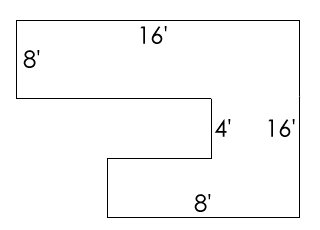 at the top
of the graphic, is where the "HO" and "O" gauges are kept. The "G" gauge
wraps itself from the bottom leg of the "U" and up to the top and through
our mountain.
at the top
of the graphic, is where the "HO" and "O" gauges are kept. The "G" gauge
wraps itself from the bottom leg of the "U" and up to the top and through
our mountain.
The table was constructed using pine board framing of 1x2 and 1x4 sizes, and the supports holding up the table are 2x2. The top itself was 1/2" plywood sheets, and on top of that was 1/2" Homosote.
In this picture we have begun by using 1x2 pine boards to define the slope
for our HO track to
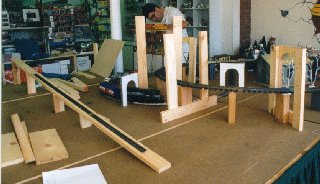 follow, as well
as the start of some supports for the mountain that we are going to build.
The reason for the track already on the slope was to determine how steep
of a slope our Heisler 4-4 engine could handle. There is a formula most model
railroaders use, and real railroad engineers for that matter, to calculate
the maximum slope for a track. Most real life engineers calculate a train
track to rise 1' in heigth for every 100' in length. Most slopes wind up
being a 2% to 3% grade, our was finished at 6%. We went well beyond the standard
slope for a couple of reasons.
follow, as well
as the start of some supports for the mountain that we are going to build.
The reason for the track already on the slope was to determine how steep
of a slope our Heisler 4-4 engine could handle. There is a formula most model
railroaders use, and real railroad engineers for that matter, to calculate
the maximum slope for a track. Most real life engineers calculate a train
track to rise 1' in heigth for every 100' in length. Most slopes wind up
being a 2% to 3% grade, our was finished at 6%. We went well beyond the standard
slope for a couple of reasons.
First, our Heisler could handle the grade even with a tender and several log cars attached. We were skeptical at first, but our little engine seemed to be able to handle almost anything we could throw at it. The second reason for increasing the slope was to have the elevation finish at a point where we could integrate our waterfall and still keep things looking good.
Now that the supports were in place, we could start attaching the portals for the "G" gauge, and the foam core supports for the top of our mountain. Moira, the artist of our group, helped us create the foam core cutouts. She made sure that the cutouts were attached securely with a hot glue gun to the top of the wooden supports, and that they looked like a real mountain landscape would.
This is the beginning stage for our mountain to begin taking shape in order to support the geodesic foam sheets that we would be using to form the actual body of the mountain.
Now the fun begins. We used a new product on the market from Bragdon Enterprises
to create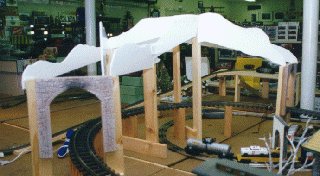 our mountain.
The whole process uses bubble-wrap, window screen, and a special foaming
resin to create "sheets" of any size and shape to create a structure. Once
the resin sets up and the screen is in place, the sheet can be molded and
cut into any shape and attached using a hot glue gun.
our mountain.
The whole process uses bubble-wrap, window screen, and a special foaming
resin to create "sheets" of any size and shape to create a structure. Once
the resin sets up and the screen is in place, the sheet can be molded and
cut into any shape and attached using a hot glue gun.
The great thing about the geodesic foam from Bragdon is that it is so
lightweight, about 2oz. per
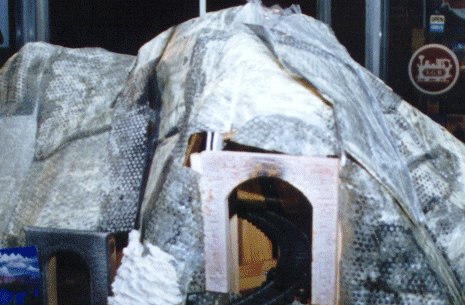 square foot. Not
only that, once the mixture cures, it is as hard as rock, rigid enough to
cut, paint, drill, etc. This was a great product to work with and is a key
to the success of our project. If you are planning to use this product we
have a couple of suggestions:
square foot. Not
only that, once the mixture cures, it is as hard as rock, rigid enough to
cut, paint, drill, etc. This was a great product to work with and is a key
to the success of our project. If you are planning to use this product we
have a couple of suggestions:
Always wear protective rubber gloves and apron when working with the product.
Lay down a drop cloth/cardboard over the table you are working at if you
care if it gets messed up. Have lots of plastic cups and stirrers available
for the resin if you are doing a large structure like us. For larger layouts,
work in teams of people creating the foam sheets and others laying them out
and glueing them.
Once we had all of the foam sheets in place, we used a lightweight joint
compond (white lines)
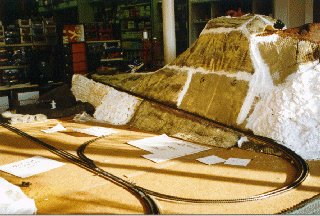 from DAP to take
care of the seams. In the foreground of the picture we were finalizing the
placement of the "HO" track. The sweeping curve going up the hill took some
time to figure out, even using flex track!
from DAP to take
care of the seams. In the foreground of the picture we were finalizing the
placement of the "HO" track. The sweeping curve going up the hill took some
time to figure out, even using flex track!
On the extreme ends of the mountain you will notice that we also have started placing our "rock" molds. This is another product from the folks at Bragdon Enterprises. Basically the process is similar to the foam sheets. In this case we used rubber molds stretched insided a wooden frame (all the details are covered in a video that comes with the product) that we filled with another resin mixture. Once the molds have setup (about 20 minutes), they can be removed from the mold and applied over the foam sheets with a hot glue gun.
This picture shows a better view of the rock molds being attached to the
foam sheets. Under
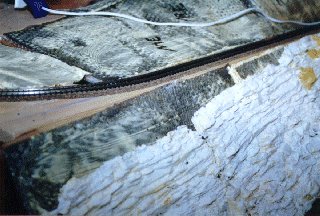 those, the wood
that we used to create the slope is still exposed to offer a great view of
how all the pieces fit together.
those, the wood
that we used to create the slope is still exposed to offer a great view of
how all the pieces fit together.
From what we could tell, Bragdon did a great job with the molds as well. Using the resin to create the rock is a two step process. The first resin sets up hard right away, and you have to add a foaming resin to the backside to give it a little more substance. However, once you lift it out of the mold, it is flexible and cuttable just like the foam sheets. HINT: When using this process to bring rocks right up to an edge, use the resins very sparingly, and you will get nice thin edges that make a nice gradual transition of the rock to another surface. Just be careful pulling them out of the mold; being so thin they have a tendancy to tear.
As the rock molds start to multiply the mountain is starting to look very
life like. To hide
some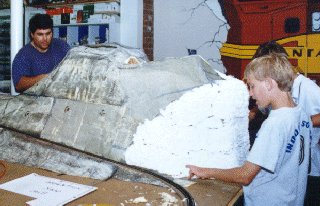 of the seams
between the rock molds, Frank and Kyle (in the foreground) are using the
same lighweight joint compound from DAP. In the background, rodney is glueing
more rock molds on the other side of the mountain.
of the seams
between the rock molds, Frank and Kyle (in the foreground) are using the
same lighweight joint compound from DAP. In the background, rodney is glueing
more rock molds on the other side of the mountain.
Once that we were satisfied with the placement of the rock molds, we wanted to cover the remainder of the mountain with some type of uniform texture or coating to add another layer to the mountain and help hide some of the construction.
Moira came up with a great idea to use a textured paint. Now with a plan
we went to Home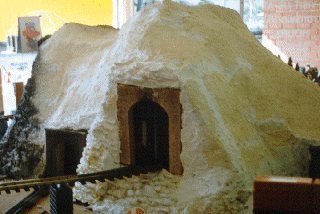 Depot and found some "OOPS" paint. "OOPS" paint, is paint that the store
mixed incorrectly, or that the customer has reurned. There is no quality
difference, and it can be purchased for a steep discount. We found a gallon
of premium paint ( $20 normally) for only $3 in an off-white/beige. Now that
we had the paint we bought some texture compound that comes in littel bags.
There are different types, fine, medium, and coarse, and we settle for medium.
The cost for the texture compound was $4.50 and all we had to do was stir
it into the paint that we had just found. We were really happy...for under
$10 bucks we had enough texture paint to cover our mountain and then some.
HINT: Moira says if you are applying the textured paint with a roller use
a short nap roller. Long nap rollers get clogged with the texture and are
ruined fairly quickly.
Depot and found some "OOPS" paint. "OOPS" paint, is paint that the store
mixed incorrectly, or that the customer has reurned. There is no quality
difference, and it can be purchased for a steep discount. We found a gallon
of premium paint ( $20 normally) for only $3 in an off-white/beige. Now that
we had the paint we bought some texture compound that comes in littel bags.
There are different types, fine, medium, and coarse, and we settle for medium.
The cost for the texture compound was $4.50 and all we had to do was stir
it into the paint that we had just found. We were really happy...for under
$10 bucks we had enough texture paint to cover our mountain and then some.
HINT: Moira says if you are applying the textured paint with a roller use
a short nap roller. Long nap rollers get clogged with the texture and are
ruined fairly quickly.
Adding realism to the layout was a big concern with the class, and we spent a long time talking about different ideas. One idea that wouldn't go away, much to Ron's dismay, was the idea of including "live" water in our layout. After kicking it around for a couple of weeks, Ron finally gave in and he purchased a waterfall fixture that we could build directly into the layout.
The next picture shows Kent wiring the pump to the electrical power.
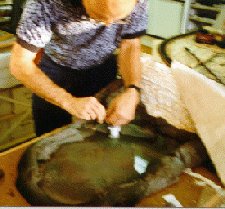 Following that,
we are a little further along and have integrated the waterfall with the
mountain. Once again we used the rock molds to create a transition into our
lake and waterfall
combination.
Following that,
we are a little further along and have integrated the waterfall with the
mountain. Once again we used the rock molds to create a transition into our
lake and waterfall
combination.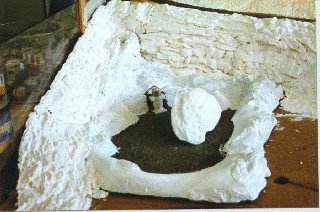
Probably one of the single greatest improvements to the layout was the night
that we began 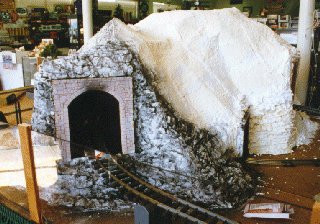 adding
the dry tempra paints to the rocks. The differnce in how our mountain looked
was amazing! To use dry tempra paints, you basically apply them with a dry
brush, and then spray it with water. After you spray it with water, the next
step is to mop up the paint with a damp sponge. Although this was an easy
task, it added an incredible amount of depth and realism to our mountain.
adding
the dry tempra paints to the rocks. The differnce in how our mountain looked
was amazing! To use dry tempra paints, you basically apply them with a dry
brush, and then spray it with water. After you spray it with water, the next
step is to mop up the paint with a damp sponge. Although this was an easy
task, it added an incredible amount of depth and realism to our mountain.
This is another vantage point of the layout. From here you can see that we
have all of the "HO"
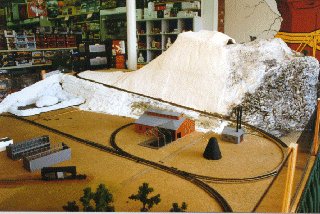 track now layed
out and ready for ballasting. We have some of the buildings approximately
where they will be when they are finished being built and painted. The rock
molds at the right of the picture have received a good amount of the dry
tempra paint
track now layed
out and ready for ballasting. We have some of the buildings approximately
where they will be when they are finished being built and painted. The rock
molds at the right of the picture have received a good amount of the dry
tempra paint
Here we have begun testing how detailed we want to get with the layout and
how different
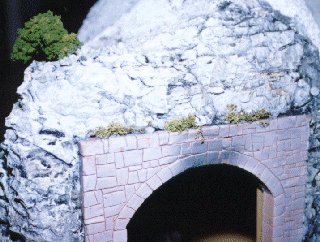 techniques will
look. The leichen and rocks were supplied by Woodland Scenics, and looked
great pearched up on top of the portal.
techniques will
look. The leichen and rocks were supplied by Woodland Scenics, and looked
great pearched up on top of the portal.
This is also a good close up of how the dry tempra paint looks. This is a huge difference from that stark white that the rock molds have after they are poured. Sorry about the flash.....
Here is one of our engines taking a maiden voyage around the table level
loop. As you can see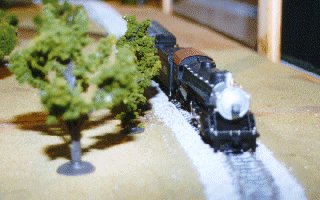 here, we have ballasted the tracks, and have started making some of the trees
that we will use on the layout. There's that darn flash again....sorry.
here, we have ballasted the tracks, and have started making some of the trees
that we will use on the layout. There's that darn flash again....sorry.
We will continue to update this page on a regular basis (as soon as we learn how to use a camera flash :-) ) so please stay tuned and visit this site often. If you have any questions for us on how we started our layout or how we did some of the construction send an email to Ron. He can also help you obtain any of the materials that we have used. Ron's World will ship anywhere on the planet, so send an email, or give him a call at (714) 361-5596